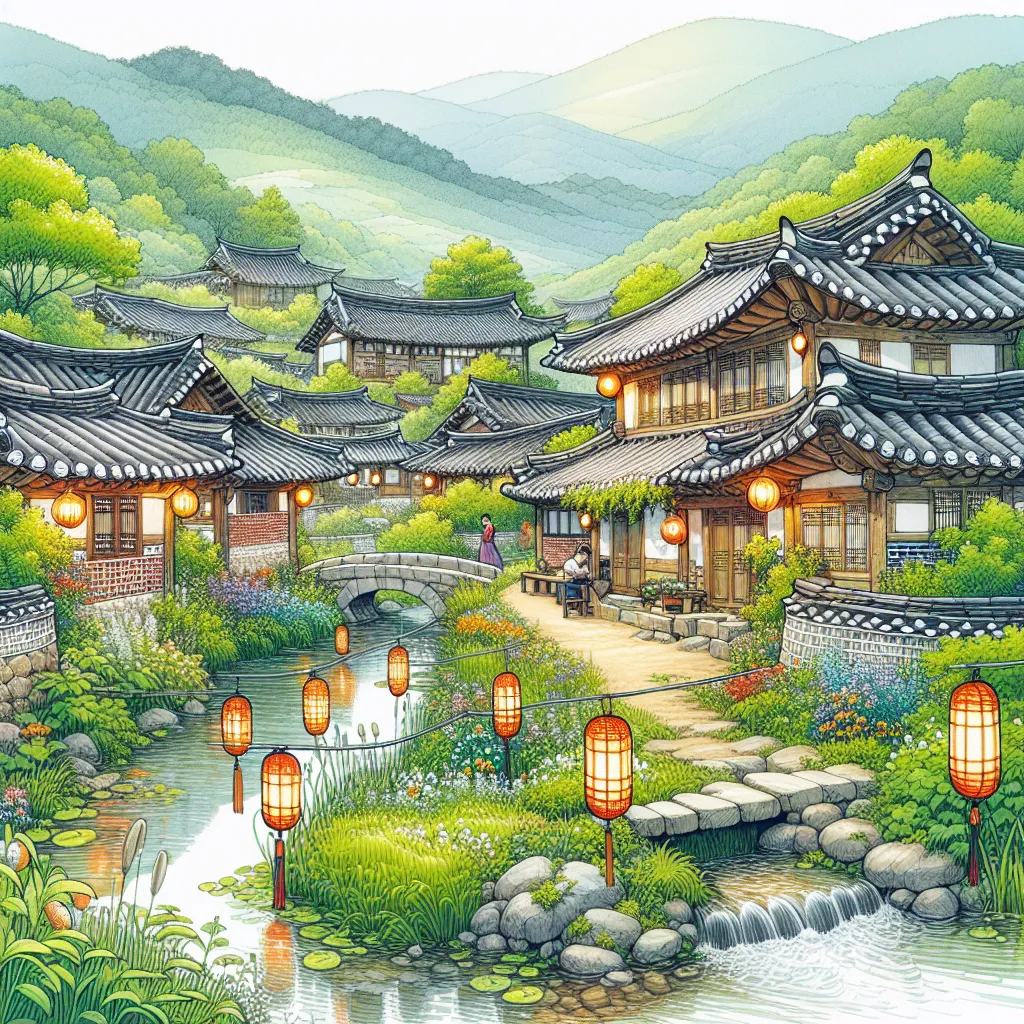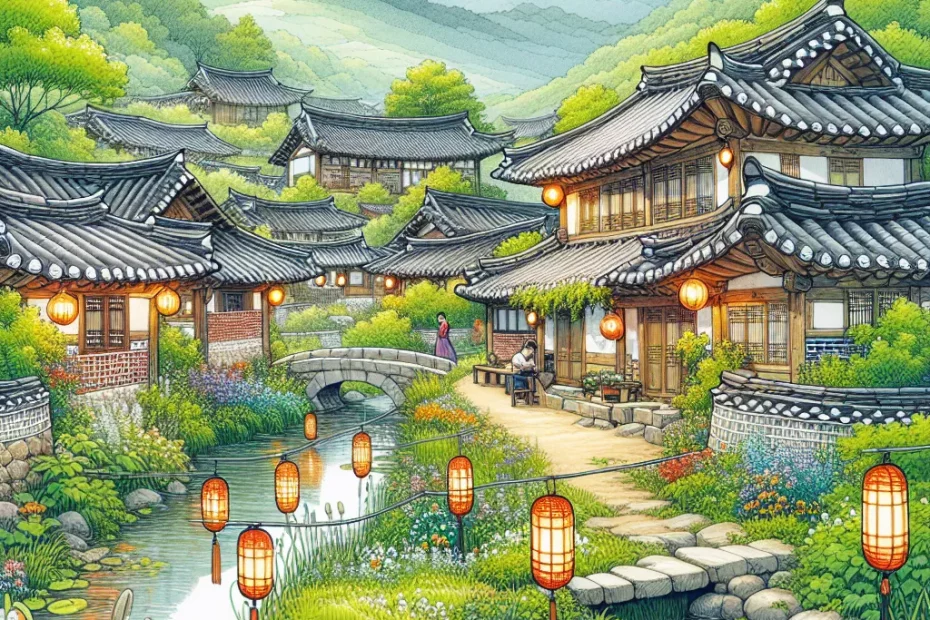Rediscovering Korea’s Hanok Villages: Preserving Traditional Korean Architecture
In the heart of South Korea, there lies a treasure trove of traditional Korean architecture known as Hanok villages. These villages, with their unique charm and historical significance, offer a glimpse into Korea’s rich cultural heritage. As efforts to preserve traditional Korean architecture gain momentum, Hanok villages stand as a testament to the country’s commitment to honoring its past while embracing the future. From the intricate design of the traditional Hanok houses to the modern adaptations that blend seamlessly with the old, each corner of these villages tells a story of Korea’s architectural evolution. The cultural significance of Hanok architecture cannot be overstated, as it serves as a living museum of Korea’s past, a source of inspiration for contemporary architects, and a symbol of national pride. As we delve into the world of Hanok villages, we are reminded of the importance of preserving our cultural heritage for future generations to cherish and learn from.

Exploring the Charm of Hanok Villages
In the heart of South Korea, nestled among modern skyscrapers and bustling city streets, lie hidden treasures that have withstood the test of time – Hanok villages. These traditional Korean houses, known for their elegant architecture and cultural significance, offer a glimpse into Korea’s rich history and heritage. 🏯
The Beauty of Hanok Villages
Hanok villages, such as Bukchon Hanok Village in Seoul and Jeonju Hanok Village in Jeonju, are not just tourist attractions but living, breathing communities where locals still reside. The meticulous design of Hanok houses, with their curved tiled roofs and wooden structures, reflects the harmony between nature and human life. 🌿
Tradition Meets Modernity
One of the most fascinating aspects of Hanok villages is the way they seamlessly blend tradition with modernity. While preserving the architectural integrity of the past, many Hanok houses have been renovated to include modern amenities such as underfloor heating and Wi-Fi connectivity. This harmonious coexistence of old and new is what makes Hanok villages truly unique. 🌟
A Glimpse into Korean Culture
Walking through the narrow alleyways of a Hanok village, visitors can experience the tranquility and simplicity of traditional Korean life. The peaceful atmosphere, the sound of wind chimes, and the scent of pine trees evoke a sense of nostalgia for a bygone era. It’s a journey back in time, a chance to disconnect from the chaos of the modern world and reconnect with the roots of Korean culture. 🌸
Preservation of Heritage
Moreover, Hanok villages play a crucial role in preserving Korea’s architectural heritage. With rapid urbanization and modernization, many traditional houses have been demolished to make way for high-rise buildings. Hanok villages serve as a reminder of the importance of preserving and celebrating the unique architectural style that defines Korean identity. 🏡
Sustainable Living Practices
In addition to their cultural significance, Hanok villages also contribute to sustainable living practices. The design of Hanok houses, with their natural ventilation and heating systems, is eco-friendly and energy-efficient. By promoting the principles of sustainability and harmony with nature, Hanok villages serve as models for environmentally conscious living. 🌱
Celebrating Korean Identity
In conclusion, exploring Hanok villages is not just a journey through time, but a celebration of Korean culture, history, and architectural ingenuity. These hidden gems offer a glimpse into a world where tradition meets modernity, and where the past is preserved for future generations to appreciate. Visiting a Hanok village is not just a sightseeing experience, but a soul-stirring immersion into the essence of Korean identity. 🌺
Preservation Efforts for Korean Traditional Architecture
In recent years, there has been a growing awareness of the importance of preserving Korea’s traditional architecture, particularly the iconic Hanok villages. These villages, with their distinct architectural style and historical significance, serve as a window into Korea’s rich cultural heritage. Efforts to safeguard and promote these traditional structures have become a focal point for cultural preservationists and architectural enthusiasts alike. 🏯
The Restoration and Maintenance of Hanok Houses
One of the key initiatives in the preservation of Korean traditional architecture is the restoration and maintenance of Hanok houses. These houses, characterized by their curved tiled roofs, wooden beams, and intricate lattice windows, require meticulous care to ensure their longevity. By implementing regular maintenance schedules and utilizing traditional building techniques, experts aim to preserve these architectural treasures for future generations to appreciate. 🔨
Government Support for Conservation
Furthermore, government support plays a crucial role in the conservation of Hanok villages. Through funding programs and regulatory measures, authorities aim to protect these cultural landmarks from modern development pressures. By designating certain areas as cultural heritage sites and providing incentives for property owners to maintain traditional structures, the government actively contributes to the preservation efforts. 🏛️
Public Awareness and Educational Programs
In addition to governmental support, public awareness campaigns and educational programs also play a significant role in promoting the value of Korean traditional architecture. By organizing cultural events, workshops, and guided tours, the public is given the opportunity to learn about the history and significance of Hanok villages. This increased awareness fosters a sense of pride and responsibility among the community to protect and cherish these architectural gems. 🌟
Integration of Modern Technology
The integration of modern technology in the preservation efforts for Korean traditional architecture is another noteworthy development. Advanced imaging techniques, such as 3D scanning and virtual reality, are being used to document and analyze Hanok structures in intricate detail. This digital preservation not only aids in the restoration process but also serves as a valuable educational tool for researchers and enthusiasts. 💻
In conclusion, the preservation of Korean traditional architecture, particularly Hanok villages, is a multifaceted endeavor that requires collaboration between government agencies, cultural organizations, and the public. By combining traditional craftsmanship with modern innovation and fostering a sense of cultural pride, we can ensure that these architectural marvels continue to stand as a testament to Korea’s rich heritage. Let us join hands in preserving and celebrating the beauty of Korean traditional architecture for generations to come! 🌺
Modern Adaptations of Hanok Villages
In recent years, there has been a resurgence of interest in preserving traditional Korean architecture, particularly in the form of Hanok villages. These villages, characterized by their unique design, use of natural materials, and harmony with nature, have become not only a cultural heritage but also a source of inspiration for modern architects and designers.
Sustainability in Modern Adaptations
One of the key aspects of modern adaptations of Hanok villages is the incorporation of sustainable practices. By utilizing eco-friendly materials such as wood, clay, and stone, architects are able to create buildings that are not only aesthetically pleasing but also environmentally friendly. This focus on sustainability is essential in today’s world, where the need to reduce our carbon footprint is more pressing than ever.
Innovative Design Elements
Furthermore, modern adaptations of Hanok villages often feature innovative design elements that blend traditional Korean architecture with contemporary styles. Architects are experimenting with new ways to maximize natural light, improve ventilation, and create spaces that are both functional and beautiful. The result is a harmonious blend of old and new, where the past is honored while the future is embraced.
Community Engagement
In addition to sustainability and innovative design, modern adaptations of Hanok villages also prioritize community engagement. Many of these projects involve local residents in the planning and construction process, ensuring that the new developments are not only visually appealing but also serve the needs of the community. This collaborative approach fosters a sense of ownership and pride among residents, further strengthening the bond between the past and the present.
As we move forward into a more sustainable and interconnected future, the modern adaptations of Hanok villages serve as a shining example of how traditional architecture can be preserved and reimagined for generations to come. By embracing sustainability, innovative design, and community engagement, these projects are not just buildings; they are living testaments to the enduring beauty and wisdom of Korean culture. Let’s celebrate this harmonious blend of tradition and modernity, where the past whispers to the future and the present shines with promise! 🌿🏡✨
Cultural Significance of Hanok Architecture
In the realm of architectural heritage, Hanok, traditional Korean houses, stand as a testament to Korea’s rich cultural history and architectural prowess. These iconic structures, characterized by their elegant curved rooflines and wooden framework, hold a deep cultural significance that transcends mere aesthetics. 🏯
Rooted in Korean Philosophy
Hanok architecture is deeply rooted in Korean philosophy and traditional values. The layout of Hanok houses is designed to harmonize with the natural surroundings, embodying the Confucian principles of balance and order. The ondol heating system, an underfloor heating system unique to Hanok houses, reflects the Korean emphasis on practicality and efficiency in design. 🌿
Preservation of Hanok Villages
The preservation of Hanok villages is crucial not only for architectural conservation but also for cultural heritage. These villages serve as living museums, offering a glimpse into Korea’s past way of life. The Bukchon Hanok Village in Seoul, for example, showcases the beauty and elegance of traditional Korean architecture, attracting tourists and locals alike. 🏘️
Renewed Interest and Fusion with Modern Designs
In recent years, there has been a renewed interest in Hanok architecture, with many architects incorporating traditional elements into modern designs. This fusion of old and new not only preserves Korea’s architectural heritage but also ensures its relevance in the contemporary world. The intricate wooden lattice work, known as “giwa,” and the use of natural materials like clay and wood, add a touch of authenticity to modern buildings. 🌟
Promotion of Sustainable Living
Furthermore, Hanok architecture promotes sustainable living practices. The design of Hanok houses allows for natural ventilation and lighting, reducing the need for artificial heating and cooling. This eco-friendly approach aligns with modern efforts towards sustainability and green architecture. 🌳
In conclusion, Hanok architecture is more than just a style of building; it is a reflection of Korea’s cultural identity and values. By preserving Hanok villages and integrating traditional elements into modern architecture, Korea pays homage to its rich heritage while embracing the future. Let us continue to cherish and celebrate the cultural significance of Hanok architecture for generations to come! 🌺
Rediscovering Korea’s Hanok Villages is not just about preserving traditional architecture; it’s a journey into the heart of Korean culture and history. By exploring the charm of these villages, we gain a deeper appreciation for the craftsmanship and wisdom of our ancestors. The preservation efforts being made to protect these architectural gems are crucial in maintaining our cultural identity and heritage for future generations to enjoy. As modern adaptations of Hanok villages continue to evolve, they serve as a bridge between the past and the present, showcasing the timelessness of Korean architecture. The cultural significance of Hanok architecture cannot be understated, as it reflects the values, beliefs, and spirit of the Korean people throughout history. Rediscovering Hanok villages is not just about preserving buildings; it’s about honoring our past, celebrating our present, and shaping our future.
